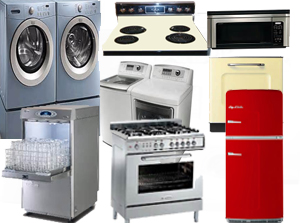Electrical Tests
How To Perform An Electrical Test
Troubleshooting
Dishwashers
Disposals
Dryers
Ice Makers (or Icemakers)
Microwave Ovens
Electric Ovens
Refrigerators and Freezers
Electric Stoves
Trash Compactors
Washers
Electrical tests fall into two broad categories: hot tests and cold tests.
- Hot Tests: tests made with power applied to the unit.
- Cold Tests: tests made with the unit unplugged.
Over 90% of the time, you’ll be measuring three different electrical parameters:
1) Continuity
2) Voltage
3) Amperage.
Continuity
- Use the “Ohms” function of your multi-meter to test for electrical continuity.
- All continuity tests are made with power removed from the appliance–that means having the appliance unplugged.
- The lower the ohms read on the meter, the greater the continuity.
- Most switches, thermostats and other contacts that are supposed to be closed should read 2 ohms or less if they have proper continuity.
- If you read something higher than this, the electrical control you’re testing is probably bad and should be replaced.
Voltage
- When testing for the presence of proper voltage, you’re looking for either 120 volts AC or 240 volts AC, depending on the type of appliance.
- When testing for voltages at electric dryer heating elements and electric range or stove elements, you’re looking for 240 volts AC.
- When testing for control voltages to solenoids, timers, etc., on washers and other 120 volts AC appliances (i.e., they do not require a 240 volt AC plug) then you’re looking for 120 volts AC.
- Anything less means you have a problem somewhere in the circuit, usually an open switch or thermostat or one with poor continuity. Sometimes it could be a bad wire connection–look for burnt or discolored wires.
Amperage
Testing for amperage, or current, is another way of testing for continuity. The main difference being that amperage tests are made with power applied to the appliance and the appliance turned on. BE CAREFUL!
You’re looking for readings in the “amps” range, not the “milliamps” range.
ApplianceQuest and its affiliates are not responsible if you injure yourself while attempting any of the test or repairs located on this website.
Our hours of operation: 24/7 For Emergency Repairs
Monday – Friday: 8 AM – 7 PM
Saturday: 8 AM – 7 PM
Sunday: CLOSED Except for Emergency Repairs .
Call Now!
(352)270-3238
© ApplianceQuest Inc.
7817 Rutillio Ct.
New Port Richey, FL 34653
# CAC1813939 # ER0015321






[…] How To Perform An Electrical Test Troubleshooting Dishwashers Disposals Dryers Ice Makers (or Icemakers) Microwave Ovens Electric Ovens Refrigerators and Freezers Electric Stoves Trash Compactors Washers […]